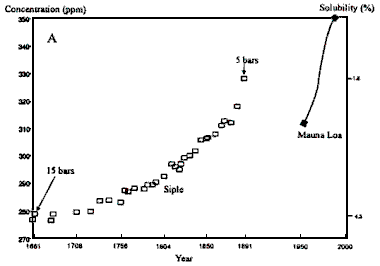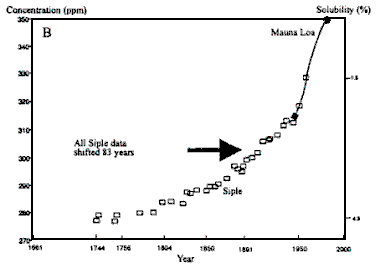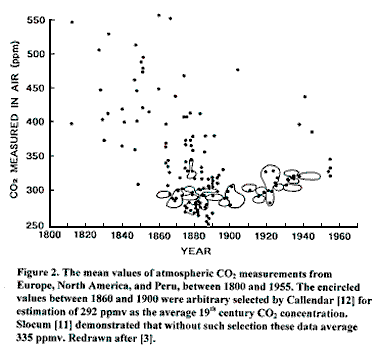|
Climate Change: Incorrect information on pre-industrial CO2
Statement written for the US Senate Committee on Commerce, Science, and Transportation March 2004 Statement of Prof. Zbigniew Jaworowski Chairman, Scientific Council of Central Laboratory for Radiological Protection Warsaw, Poland I am a Professor at the Central Laboratory for Radiological Protection (CLOR) in Warsaw, Poland, a governmental institution, involved in environmental studies. CLOR has a "Special Liaison" relationship with the US National Council on Radiological Protection and Measurements (NCRP). In the past, for about ten years, CLOR closely cooperated with the US Environmental Protection Agency, in research on the influence of industry and nuclear explosions on pollution of the global environment and population. I published about 280 scientific papers, among them about 20 on climatic problems. I am the representative of Poland in the United Nations Scientific Committee on the Effects of Atomic Radiation (UNSCEAR), and in 1980-1982 I was the chairman of this Committee. For the past 40 years I was involved in glacier studies, using snow and ice as a matrix for reconstruction of history of man-made pollution of the global atmosphere. A part of these studies was related to the climatic issues. Ice core records of CO2 have been widely used as a proof that, due to man's activity the current atmospheric level of CO2 is about 25% higher than in the pre-industrial period. These records became the basic input parameters in the models of the global carbon cycle and a cornerstone of the man-made climatic warming hypothesis. These records do not represent the atmospheric reality, as I will try to demonstrate in my statement. Relevant Background In order to study the history of industrial pollution of the global atmosphere, between 1972 and 1980, I organized 11 glacier expeditions, which measured natural and man-made pollutants in contemporary and ancient precipitation, preserved in 17 glaciers in Arctic, Antarctic, Alaska, Norway, the Alps, the Himalayas, the Ruwenzori Mountains in Uganda, the Peruvian Andes and in Tatra Mountains in Poland. I also measured long-term changes of dust in the troposphere and stratosphere, and the lead content in humans living in Europe and elsewhere during the past 5000 years. In 1968 I published the first paper on lead content in glacier ice[1]. Later I demonstrated that in pre-industrial period the total flux of lead into the global atmosphere was higher than in the 20th century, that the atmospheric content of lead is dominated by natural sources, and that the lead level in humans in Medieval Ages was 10 to 100 times higher than in the 20th century. In the 1990s I was working in the Norwegian Polar Research Institute in Oslo, and in the Japanese National Institute of Polar Research in Tokyo. In this period I studied the effects of climatic change on polar regions, and the reliability of glacier studies for estimation of CO2 concentration in the ancient atmosphere. False Low Pre-industrial CO2 in the Atmosphere Determinations of CO2 in polar ice cores are commonly used for estimations of the pre-industrial CO2 atmospheric levels. Perusal of these determinations convinced me that glaciological studies are not able to provide a reliable reconstruction of CO2 concentrations in the ancient atmosphere. This is because the ice cores do not fulfill the essential closed system criteria. One of them is a lack of liquid water in ice, which could dramatically change the chemical composition the air bubbles trapped between the ice crystals. This criterion, is not met, as even the coldest Antarctic ice (down to -73°C) contains liquid water[2]. More than 20 physico-chemical processes, mostly related to the presence of liquid water, contribute to the alteration of the original chemical composition of the air inclusions in polar ice[3]. One of these processes is formation of gas hydrates or clathrates. In the highly compressed deep ice all air bubbles disappear, as under the influence of pressure the gases change into the solid clathrates, which are tiny crystals formed by interaction of gas with water molecules. Drilling decompresses cores excavated from deep ice, and contaminates them with the drilling fluid filling the borehole. Decompression leads to dense horizontal cracking of cores, by a well known sheeting process. After decompression of the ice cores, the solid clathrates decompose into a gas form, exploding in the process as if they were microscopic grenades. In the bubble-free ice the explosions form a new gas cavities and new cracks[4]. Through these cracks, and cracks formed by sheeting, a part of gas escapes first into the drilling liquid which fills the borehole, and then at the surface to the atmospheric air. Particular gases, CO2, O2 and N2 trapped in the deep cold ice start to form clathrates, and leave the air bubbles, at different pressures and depth. At the ice temperature of -15°C dissociation pressure for N2 is about 100 bars, for O2 75 bars, and for CO2 5 bars. Formation of CO2 clathrates starts in the ice sheets at about 200 meter depth, and that of O2 and N2 at 600 to 1000 meters. This leads to depletion of CO2 in the gas trapped in the ice sheets. This is why the records of CO2 concentration in the gas inclusions from deep polar ice show the values lower than in the contemporary atmosphere, even for the epochs when the global surface temperature was higher than now. 


The data from shallow ice cores, such as those from Siple, Antarctica[5, 6], are widely used as a proof of man-made increase of CO2 content in the global atmosphere, notably by IPCC[7]. These data show a clear inverse correlation between the decreasing CO2 concentrations, and the load-pressure increasing with depth (Figure 1 A) . The problem with Siple data (and with other shallow cores) is that the CO2 concentration found in pre-industrial ice from a depth of 68 meters (i.e. above the depth of clathrate formation) was "too high". This ice was deposited in 1890 AD, and the CO2 concentration was 328 ppmv, not about 290 ppmv, as needed by man-made warming hypothesis. The CO2 atmospheric concentration of about 328 ppmv was measured at Mauna Loa, Hawaii as later as in 1973[8], i.e. 83 years after the ice was deposited at Siple. 
The notion of low pre-industrial CO2 atmospheric level, based on such poor knowledge, became a widely accepted Holy Grail of climate warming models. The modelers ignored the evidence from direct measurements of CO2 in atmospheric air indicating that in 19th century its average concentration was 335 ppmv[11] (Figure 2) . In Figure 2 encircled values show a biased selection of data used to demonstrate that in 19th century atmosphere the CO2 level was 292 ppmv[12]. A study of stomatal frequency in fossil leaves from Holocene lake deposits in Denmark, showing that 9400 years ago CO2 atmospheric level was 333 ppmv, and 9600 years ago 348 ppmv, falsify the concept of stabilized and low CO2 air concentration until the advent of industrial revolution [13]. Improper manipulation of data, and arbitrary rejection of readings that do not fit the pre-conceived idea on man-made global warming is common in many glaciological studies of greenhouse gases. In peer reviewed publications I exposed this misuse of science [3, 9]. Unfortunately, such misuse is not limited to individual publications, but also appears in documents of national and international organizations. For example IPCC not only based its reports on a falsified "Siple curve", but also in its 2001 report[14] used as a flagship the "hockey curve" of temperature, showing that there was no Medieval Warming, and no Little Ice Age, and that the 20th century was unusually warm. The curve was credulously accepted after Mann et al. paper published in NATURE magazine[15]. In a crushing criticism, two independent groups of scientists from disciplines other than climatology [16, 17] (i.e. not supported from the annual pool of many billion "climatic" dollars), convincingly blamed the Mann et al. paper for the improper manipulation and arbitrary rejections of data. The question arises, how such methodically poor paper, contradicting hundreds of excellent studies that demonstrated existence of global range Medieval Warming and Little Ice Age, could pass peer review for NATURE? And how could it pass the reviewing process at the IPCC? The apparent scientific weaknesses of IPCC and its lack of impartiality, was diagnosed and criticized in the early 1990s in NATURE editorials [18, 19]. The disease, seems to be persistent. Conclusion The basis of most of the IPCC conclusions on anthropogenic causes and on projections of climatic change is the assumption of low level of CO2 in the pre-industrial atmosphere. This assumption, based on glaciological studies, is false. Therefore IPCC projections should not be used for national and global economic planning. The climatically inefficient and economically disastrous Kyoto Protocol, based on IPCC projections, was correctly defined by President George W. Bush as "fatally flawed". This criticism was recently followed by the President of Russia Vladimir V. Putin. I hope that their rational views might save the world from enormous damage that could be induced by implementing recommendations based on distorted science. References 1. Jaworowski, Z., Stable lead in fossil ice and bones. Nature, 1968. 217: p. 152-153. 2. Mulvaney, R., E.W. Wolff, and K. Oates, Sulpfuric acid at grain boundaries in Antarctic ice. Nature, 1988. 331(247-249). 3. Jaworowski, Z., T.V. Segalstad, and N. Ono, Do glaciers tell a true atmospheric CO2 story? The Science of the Total Environment, 1992. 114: p. 227-284. 4. Shoji, H. and C.C. Langway Jr., Volume relaxation of air inclusions in a fresh ice core. Journal of Physical Chemistry, 1983. 87: p. 4111-4114. 5. Neftel, A., et al., Evidence from polar ice cores for the increase in atmospheric CO2 in the past two centuries. Nature, 1985. 315: p. 45-47. 6. Friedli, H., et al., Ice core record of the 13C/12C ratio of atmospheric CO2 in the past two centuries. Nature, 1986. 324: p. 237-238. 7. IPCC, Climate Change - The IPCC Scientific Assessment. ed. J.T. Houghton et al. 1990, Cambridge University Press: Cambridge, pp. 364. 8. Boden, T.A., P. Kanciruk, and M.P. Farrel, TRENDS '90 - A Compendium of Data on Global Change. 1990, Oak Ridge National Laboratory: Oak Ridge, Tennssee, pp. 257. 9. Jaworowski, Z., Ancient atmosphere - validity of ice records. Environ. Sci. & Pollut. Res., 1994. 1(3): p. 161-171. 10. Schwander, J., et al., The age of the air in the firn and the ice at Summit, Greenland. J. Geophys. Res., 1993. 98(D2): p. 2831-2838. 11. Slocum, G., Has the amount of carbon dioxide in the atmosphere changed significantly since the beginning of the twentieth century? Month. Weather Rev., 1955(October): p. 225-231. 12. Callendar, G.S., On the amount of carbon dioxide in the atmosphere. Tellus, 1958. 10: p. 243-248. 13. Wagner, F., et al., Century-scale shifts in Early Holocene atmospheric CO2 concentration. Science, 1999. 284: p. 1971-1973. 14. IPCC, Climate Change 2001: The Scientific Basis., ed. J.T. Houton et al. 2001, Cambridge: Cambridge University Press, pp. 892. 15. Mann, M.E., R.S. Bradley, and M.K. Hughes, Global-scale temperature patterns and climate forcing over the past six centuries. Nature, 1998. 392: p. 779-787. 16. Soon, W., et al., Reconstructing Climatic and Environmental Changes of the past 1000 years: A Reappraisal. Energy & Environment, 2003. 14: p. 233-296. 17. McIntyre, S. and R. McKitrick, Corrections to the Mann et al. (1998) proxy data base and Northern hemispheric average temperature series. Energy & Environment, 2003. 14(6): p. 751-771. 18. Editorial, A., IPCC's ritual on global warming. Nature, 1994. 371: p. 269. 19. Maddox, J., Making global warming public property. Nature, 1991. 349: p. 189. * * * * * * * * * * * * * * End of Jaworowski Statement * * * * * * * * * * * The following are not part of the above statement, but have been added locally. At least somewhat related to reference 13, Rapid atmospheric CO2 changes associated with the 8,200-years-B.P. cooling event contains additional discussion of stomatal indications of early Holocene atmospheric CO2 concentrations in excess of 280 ppmv. For additional information regarding reference 17, see McIntyre and McKitrick web pages. |